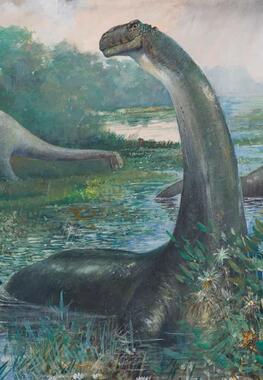Hey, Where Did All the Big Dinos Go?
While the early Cretaceous Period flourished with life, the end of this period was the end of the line for all dinosaurs except birds. Scientists have proposed many theories for the cause of mass extinctions, but no one theory answers all the questions. One theory suggests that a huge asteroid or comet crashed into Earth causing fires, high winds, acid rain, tsunamis (or tidal waves), and a severe lack of sunlight for months. Another theory suggests that volcanic eruptions spewed dust all around the planet causing environmental changes. Still others say deadly diseases or sea level changes caused the mass extinction.
Pronunciation: kruh-TAY-shus
What It Is: a geologic period of time that spanned the last 79 million years of the Mesozoic Era
When: 144 to 65 million years ago
Name Origin: from the Latin Creta, meaning "chalk"
Significance: The Cretaceous Period marked the end of the line for all non-avian dinosaurs. However, fossil evidence indicates that many groups of animals and plants that exist on Earth today evolved during this period.

Which group of dinosaurs first appeared during the Cretaceous Period?
ceratopians
sauropods
theropods
Correct!
Both sauropods and theropods evolved before the Cretaceous Period. Ceratopians, such as Triceratops, appeared during the Cretaceous.
Which of these flowering plants appeared during the Cretaceous Period?
magnolia
marigold
roses
Correct!
Magnolias are flowering plants that have been around since the Cretaceous Period.
Fossils from the Cretaceous Period tell us that tiny mammals lived here more than 70 million years ago.
Fact
These tiny mammals were the ancient relatives of modern mammals such as elephants, lions, and humans.




 Biodiversity
Biodiversity
 Brain
Brain
 Genetics
Genetics
 Marine BiOLogy
Marine BiOLogy
 MicrobiOLogy
MicrobiOLogy
 PaleontOLogy
PaleontOLogy
 ZoOLogy
ZoOLogy
 AnthropOLogy
AnthropOLogy
 ArchaeOLogy
ArchaeOLogy
 Astronomy
Astronomy
 Climate Change
Climate Change
 Earth
Earth
 Physics
Physics
 Water
Water
